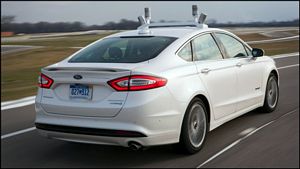|
By accessing or using The Crittenden Automotive Library™/CarsAndRacingStuff.com, you signify your agreement with the Terms of Use on our Legal Information page. Our Privacy Policy is also available there. |

Driverless Cars - The Big Question Mark
|
|---|
|
|
Driverless Cars - The Big Question Mark
Geoff Maxted
DriveWrite
December 14, 2013
The inexorable march of the autonomous car continues. Now it’s the turn of Ford to be working towards bring driverless cars to the market. They are testing now to see how the technology might be applied to reduce congestion and improve traffic safety.
The test bed for Ford’s automated driving technology is a Fusion Hybrid saloon (Mondeo) that the company showed a couple of days ago at a media briefing. The car drives itself and will be used for testing the science. The goal is to advance the technology so that it can be installed in mainstream vehicles by 2025. Renault-Nissan said earlier this year that the company plans to have driverless cars available by 2020 so Ford are playing catch-up. Robert Bosch GmbH, the world largest supplier, is developing a suite of technologies for automated driving but says the technology must be “100 percent safe 100 percent of the time” before it can be marketed.
Some of the first aspects of automated cars are already on the road but have had mixed acceptance. Toyota’s Lexus division was first with an automated parking system in 2006 but later dropped the option because of slow sales. Ford offers automated parking in several vehicles, and dozens more are available with lane assist, which keeps the vehicle from drifting out of its lane. The Fusion saloon is available, in the USA, with some of the technology that can be used for automated driving, such as the self-parking system, lane-departure warning and adaptive cruise control.
“In the future, automated driving may well help us improve driver safety and manage issues such as traffic congestion and global gridlock, yet there are still many questions that need to be answered and explored to make it a long-term reality,” said Raj Nair, group vice president for Ford global product development showing a commendable bit of common sense. He went on, “With the automated Ford Fusion Hybrid research project, our goal is to test the limits of full automation and determine the appropriate levels for near and mid-term deployment.”
Ford has been tinkering with self-driving vehicles for about a decade. The company has been using self-guided cars, for example, to help engineers test vehicles. The Fusion research vehicle uses four LiDAR -- Light Detection And Ranging -- sensors to scan the road 2.5 million times a second, according to Ford. The system bounces light off everything around the car up to 200 feet and creates a real-time 3D map. That data is used to keep the car safely on the road and at the proper distance from other vehicles.
So that’s the company side but what do real people think? One respondent on the subject said that he had driven over one million accident free miles and rather than 200ft he watches for lane changes, brake lights and the like a half mile ahead or more. Another chap wonders what happens when a dog runs out in front of such a car. What course of action will the car take?
That’s the big question. A lot of the gear used is already appearing as safety features on our cars and most of it is valid. Certainly there are plenty of terminally stupid drivers who may not react as quickly as an automated system but without the judgment of a human brain in an emergency, can an automatic system ever be sophisticated enough to make the ‘right’ decision?

















 Topics: Ford Motor Company
Topics: Ford Motor Company

